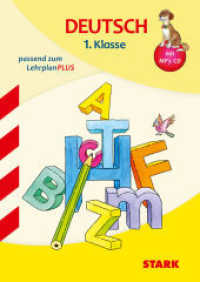Full Description
"The authors illustrate how to teach to the standards using literature. More important, they explain why it is essential to do so if we are to prepare our children for life in a 21st-century global society."
—Carol Gallegos, Literacy Coach
Hanford Elementary, CA
"The authors skillfully weave global-text titles, authors, websites, and strategy instruction throughout the book."
—Victoria Seeger, Instructional Coach
Pleasant Hill Elementary School, Topeka, KS
Discover how global literature can prepare your students for global citizenship!
With an increasingly diverse nation and an ever-smaller world, global awareness is a necessity for today's students. This unique and indispensible handbook shows how teachers can use global literature to help students expand their worldview while developing increased respect for cultural diversity.
The authors explain how to infuse global literature throughout the K-8 curriculum, from locating and selecting appropriate, high-quality books to developing related activities and projects for a variety of subject areas. Teachers, librarians, and reading coordinators will find:
Insights on how reading global literature prepares students for life and work in an interconnected world
Numerous examples of outstanding books for Grades K-8 and a fully annotated bibliography of hundreds of titles on the enclosed CD-ROM
A wealth of teaching ideas for the entire curriculum, supported by classroom vignettes
Answers to frequently asked questions about funding, cultural authenticity, and supporting state and national standards
Bring the world into your classroom through global literature to enrich teaching and learning!
Contents
List of Figures
Acknowledgments
About the Authors
Introduction
Organization of Book
1. The Need for Global Literature
The Importance of Global Literature in Children's Lives
The Contemporary Context
History and Availability of Global Children's Literature
Global Literature Defined
Goals for Global Literature
Conclusion
Part I: Infusing Global Literature Throughout the Curriculum
2. Literary Theme Studies and an Integrated Curriculum
A Literary Framework
Incorporating the Framework Across the Curriculum
Theme Studies
Integrating the Curriculum
Conclusion
3. Integrated Language Arts
IRA/NCTE Standards for the English Language Arts
Conclusion
4. Social Studies
Topic 1: "Wake Up World" (Primary Grades)
Topic 2: World War II and the Holocaust (Upper Elementary/Middle School)
Curriculum Strand: Individual Development and Identity (Upper Elementary/Middle School)
Curriculum Strand: Individuals, Groups, and Institutions (Primary Grades)
Biographies and Memoirs (Upper Elementary/Middle School)
Seeking Peace and Justice (All Grades)
Conclusion
5. Science and Mathematics
Children's Literature and STEM Education
Animals: Other Creatures That Share Our Earth
Life Cycles and Other Patterns
Habitats around the World
Environmental Change and the Need for Conservation
World Health Awareness
Technology: The Benefits, Risks, Costs, and Ethical Issues
How Things Are Made and How They Work
Scientific and Mathematical Contributions from Diverse Cultures
Earning, Saving, and Investing Money
Conclusion
6. The Arts
Music and Dance
Art and Artists
Drama
Conclusion
Part II: Issues Teachers Face
7. How Should I Evaluate Global Books?
How Can I Know If These Books Are Authentic?
What Else Do I Need to Know to Make Good Book Selections?
Conclusion
8. Frequently Asked Questions about Global Children's Literature
How can I fund the purchase of global children's literature for my classroom and school library?
How should we decide what books to buy?
How can I work with colleagues to plan for using global children's literature across the grades?
What's the best way to handle sensitive topics like war, prejudice, human injustices, and cultural taboos like bodily functions or practices?
How should I respond if parents object to a book?
How can I help my students relate to places, people, times, and events they have never seen, heard, or experienced?
How can I help parents understand the importance of global literature?
How do I fit global literature into our district-mandated curricula that occupy much of the day?
How does global literature contribute to meeting state and national standards?
Will using global literature raise test scores?
9. What's Next? Going Global and Bringing It Home
Getting Started
Final Thoughts
References
Index
The CD
Further Recommended Reading for Teadhers
Resources for Locating and Learning More about Global Children's Literature
An Annotated List of 341 Children's Books Cited in the Book








